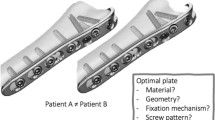Abstract
Objective
To validate femoral version measurements made from biplanar radiography (BR), three-dimensional (3D) reconstructions (EOS imaging, France) were made in differing rotational positions against the gold standard of computed tomography (CT).
Materials and methods
Two cadaveric femurs were scanned with CT and BR in five different femoral versions creating ten total phantoms. The native version was modified by rotating through a mid-diaphyseal hinge twice into increasing anteversion and twice into increased retroversion. For each biplanar scan, the phantom itself was rotated −10, −5, 0, +5 and +10°. Three-dimensional CT reconstructions were designated the true value for femoral version. Two independent observers measured the femoral version on CT axial slices and BR 3D reconstructions twice. The mean error (upper bound of the 95 % confidence interval), inter- and intraobserver reliability, and the error compared to the true version were determined for both imaging techniques.
Results
Interobserver intraclass correlation for CT axial images ranged from 0.981 to 0.991, and the intraobserver intraclass correlation ranged from 0.994 to 0.996. For the BR 3D reconstructions these values ranged from 0.983 to 0.998 and 0.982 to 0.998, respectively. For the CT measurements the upper bound of error from the true value was 5.4–7.5°, whereas for BR 3D reconstructions it was 4.0–10.1°. There was no statistical difference in the mean error from the true values for any of the measurements done with axial CT or BR 3D reconstructions.
Conclusion
BR 3D reconstructions accurately and reliably provide clinical data on femoral version compared to CT even with rotation of the patient of up to 10° from neutral.






Similar content being viewed by others
References
Brouwer KJ, Molenaar JC, van Linge B. Rotational deformities after femoral shaft fractures in childhood. A retrospective study 27–32 years after the accident. Acta Orthop Scand. 1981;52(1):81–9.
Leonardi F, Rivera F, Zorzan A, Ali SM. Bilateral double osteotomy in severe torsional malalignment syndrome: 16 years follow-up. J Orthop Traumatol. 2013;15:131–6.
Folinais D, Thelen P, Delin C, Radier C, Catonne Y, Lazennec JY. Measuring femoral and rotational alignment: EOS system versus computed tomography. Orthop Traumatol Surg Res: OTSR. 2013;99(5):509–16.
Sankar WN, Neubuerger CO, Moseley CF. Femoral anteversion in developmental dysplasia of the hip. J Pediatr Orthop. 2009;29(8):885–8.
Wines AP, McNicol D. Computed tomography measurement of the accuracy of component version in total hip arthroplasty. J Arthroplasty. 2006;21(5):696–701.
Daly PJ, Morrey BF. Operative correction of an unstable total hip arthroplasty. J Bone Joint Surg Am. 1992;74(9):1334–43.
Kim HT, Wenger DR. “Functional retroversion” of the femoral head in Legg-Calve-Perthes disease and epiphyseal dysplasia: analysis of head-neck deformity and its effect on limb position using three-dimensional computed tomography. J Pediatr Orthop. 1997;17(2):240–6.
Gelberman RH, Cohen MS, Shaw BA, Kasser JR, Griffin PP, Wilkinson RH. The association of femoral retroversion with slipped capital femoral epiphysis. J Bone Joint Surg Am. 1986;68(7):1000–7.
Stanitski CL, Woo R, Stanitski DF. Femoral version in acute slipped capital femoral epiphysis. J Pediatr Orthop B. 1996;5(2):74–6.
Ruwe PA, Gage JR, Ozonoff MB, DeLuca PA. Clinical determination of femoral anteversion. A comparison with established techniques. J Bone Joint Surg Am. 1992;74(6):820–30.
Ogata K, Goldsand EM. A simple biplanar method of measuring femoral anteversion and neck-shaft angle. J Bone Joint Surg Am. 1979;61(6A):846–51.
Abel MF, Sutherland DH, Wenger DR, Mubarak SJ. Evaluation of CT scans and 3-D reformatted images for quantitative assessment of the hip. J Pediatr Orthop. 1994;14(1):48–53.
Hernandez RJ, Tachdjian MO, Poznanski AK, Dias LS. CT determination of femoral torsion. AJR Am J Roentgenol. 1981;137(1):97–101.
Kuo TY, Skedros JG, Bloebaum RD. Measurement of femoral anteversion by biplane radiography and computed tomography imaging: comparison with an anatomic reference. Investig Radiol. 2003;38(4):221–9.
Brenner DJ, Hall EJ. Computed tomography–an increasing source of radiation exposure. N Engl J Med. 2007;357(22):2277–84.
Delin C, Silvera S, Bassinet C, Thelen P, Rehel JL, Legmann P, et al. Ionizing radiation doses during lower limb torsion and anteversion measurements by EOS stereoradiography and computed tomography. Eur J Radiol. 2014;83(2):371–7.
Buck FM, Guggenberger R, Koch PP, Pfirrmann CW. Femoral and tibial torsion measurements with 3D models based on low-dose biplanar radiographs in comparison with standard CT measurements. AJR Am J Roentgenol. 2012;199(5):W607–612.
Rosskopf AB, Ramseier LE, Sutter R, Pfirrmann CW, Buck FM. Femoral and tibial torsion measurement in children and adolescents: comparison of 3D models based on low-dose biplanar radiography and low-dose CT. AJR Am J Roentgenol. 2014;202(3):W285–291.
Gelaude F, Vander Sloten J, Lauwers B. Accuracy assessment of CT-based outer surface femur meshes. Comput Aided Surg: Off J Int Soc Comput Aided Surg. 2008;13(4):188–99.
Malviya S, Voepel-Lewis T, Eldevik OP, Rockwell DT, Wong JH, Tait AR. Sedation and general anaesthesia in children undergoing MRI and CT: adverse events and outcomes. Br J Anaesth. 2000;84(6):743–8.
Deschenes S, Charron G, Beaudoin G, Labelle H, Dubois J, Miron MC, et al. Diagnostic imaging of spinal deformities: reducing patients radiation dose with a new slot-scanning X-ray imager. Spine (Phila Pa 1976). 2010;35(9):989–94.
Chaibi Y, Cresson T, Aubert B, Hausselle J, Neyret P, Hauger O, et al. Fast 3D reconstruction of the lower limb using a parametric model and statistical inferences and clinical measurements calculation from biplanar X-rays. Comput Methods Biomech Biomed Eng. 2012;15(5):457–66.
Saltybaeva N, Jafari ME, Hupfer M, Kalender WA. Estimates of effective dose for CT scans of the lower extremities. Radiology. 2014;132903.
Tomczak RJ, Guenther KP, Rieber A, Mergo P, Ros PR, Brambs HJ. MR imaging measurement of the femoral antetorsional angle as a new technique: comparison with CT in children and adults. AJR Am J Roentgenol. 1997;168(3):791–4.
Acknowledgments
The authors wish to acknowledge Tracey Bastrom for her statistical assistance and Christine Farnsworth for assistance with completion of the manuscript.
Conflict of interests
The authors declare that they have no conflict of interest.
Author information
Authors and Affiliations
Corresponding author
Rights and permissions
About this article
Cite this article
Pomerantz, M.L., Glaser, D., Doan, J. et al. Three-dimensional biplanar radiography as a new means of accessing femoral version: a comparitive study of EOS three-dimensional radiography versus computed tomography. Skeletal Radiol 44, 255–260 (2015). https://doi.org/10.1007/s00256-014-2031-2
Received:
Revised:
Accepted:
Published:
Issue Date:
DOI: https://doi.org/10.1007/s00256-014-2031-2




